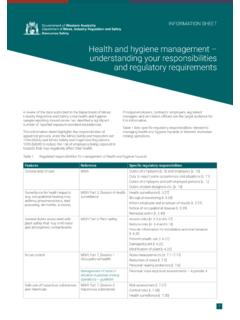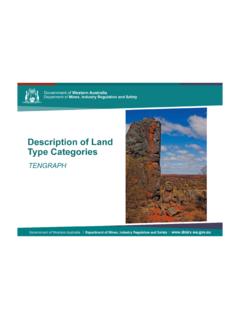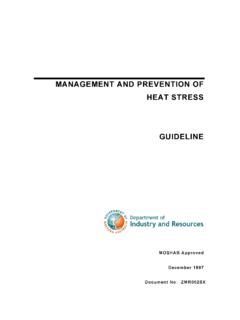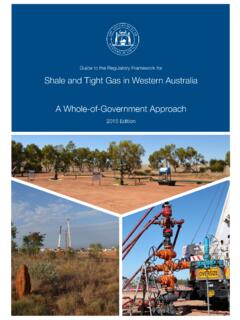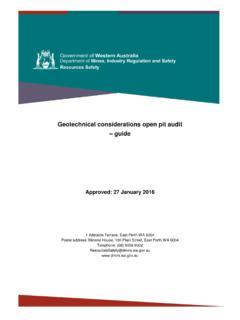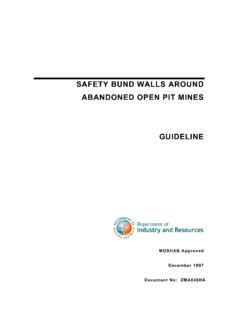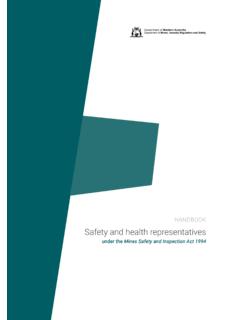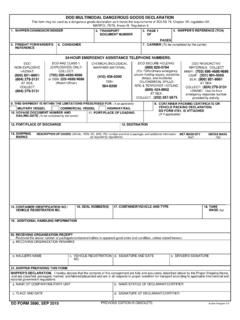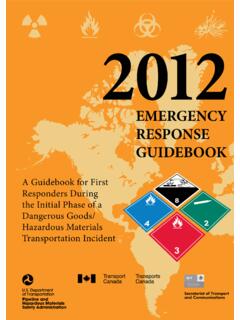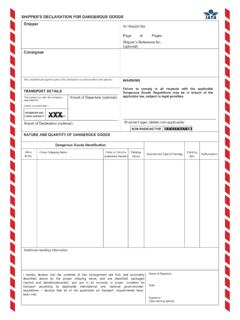Transcription of Risk assessment for dangerous goods - guide
1 dangerous goods Safety guide Risk assessment for dangerous goods May 2019 Level 2, 1 Adelaide Terrace, East Perth WA 6004 Postal address: Locked Bag 100, East Perth WA 6892 Telephone: (08) 6251 2300 Risk assessment for dangerous goods guide Page 2 of 11 Contents Introduction .. 3 Risk assessment process .. 3 Risk assessment template .. 6 Template use .. 6 Hazard identification .. 7 assessment of risk .. 8 Risk control measures .. 8 Access to risk assessment .. 9 Further information .. 9 Appendix 1 Risk score calculator .. 10 Risk assessment for dangerous goods guide Page 3 of 11 Introduction This guide will assist operators of dangerous goods sites in Western Australia to complete a risk assessment under the dangerous goods Safety (Storage and Handling of Non-Explosives) Regulations 2007 (the regulations) and demonstrate minimising risk to people, property and the environment under Section 8 of the dangerous goods Safety Act 2004 (the Act).
2 In particular, this guide will assist those storing and handling dangerous goods in quantities exceeding those specified as manifest quantities in Schedule 1 of the Regulations to comply with regulation 48 relating to risk assessment . It will also assist applicants for a dangerous goods site licence to comply with their duty to supply a risk assessment under regulation 26(2)(b). The Department provides a dangerous goods risk assessment template that can be used to formally document the risk assessment . It is not intended that use of the procedure and template should be regarded as the only way to carry out the risk assessment , but this guide does identify the types of issues that need to be addressed in a thorough risk assessment for dangerous goods .
3 Alternative processes may be used, but should give a realistic assessment of the risk. The ultimate aim of any risk assessment is to identify appropriate control measures that will reduce the risks from the dangerous goods to people, property and the environment to as low as reasonably practicable (ALARP). The risk assessment must be reviewed: at least every five years if the site is involved in a (significant) dangerous goods incident if there is a change in circumstances such that the risk assessment is no longer applicable, such as a change to the storage or handling system, the emergence of new vulnerable facilities off-site, or changes in the state of knowledge about the hazards or availability of control measures. Note: Combustible liquids are a dangerous goods for the purpose of the Regulations.
4 Risk assessment process For a dangerous goods site, a risk assessment is a document that: identifies all hazards relating to the dangerous goods at the site for each hazard assesses the probability of the hazard causing a dangerous goods incident assesses the consequences of the incident to people, property and the environment identifies the risk control measure(s) explains the rationale behind the judgements made. A separate hazard identification and risk assessment should be undertaken for each dangerous good and for each dangerous goods installation. Anyone carrying out a risk assessment should be familiar with the requirements of the regulations and have a practical understanding of how the dangerous goods are stored and handled at the site.
5 A single person such as the works manager or works chemist may be suitably competent to perform simple assessments. In more complex cases, several people representing a variety of skills will probably be involved in collecting and assessing the information. Note: If you are considering contracting the services of external consultants, ensure they are approved by the Chief dangerous goods Officer and have the expertise and experience to do the job competently. See the accredited consultant list on the Department s website. Risk assessment for dangerous goods guide Page 4 of 11 Hazard identification and risk assessment can be relatively simple or highly complex, depending on circumstances. The nature of the dangerous goods involved and complexity of the handling systems will dictate the level of complexity of the risk assessment and associated documentation.
6 The risk assessment can range from a short simple document perhaps referring to a single code of practice, to a longer more complex document that contains both approved codes of practice and risk assessments for processes not covered by any codes of practice. A major warehouse handling a large range of dangerous goods or a chemical manufacturing plant is likely to require detailed investigations of the hazards and risks, involving people who have specialist knowledge of: dangerous goods processing of those materials; safe work practices employed in connection with those materials. Figure 1 illustrates the two approaches to risk assessment one using approved codes of practice and the other based on first principles. The dangerous goods risk assessment template will assist in documenting the approach used to satisfy regulatory requirements.
7 The regulations require that the risk assessment be made available to all employees for comment and that employee comments should be considered before preparing a revised assessment or plan. At the conclusion of the risk assessment process the operator must sign and date the document. Approach using approved codes of practice Section 62 of the dangerous goods Safety Act 2004 allows the operator of a dangerous goods site to adopt and comply with approved codes of practice, where applicable ( spillage containment, impact protection), and thereby be deemed to have: achieved the outcome required by the regulations complied with the duty to minimise risk from dangerous goods as far as is reasonably practicable. Approved codes of practice provide a useful and convenient mechanism to identify most risk control measures at the majority of dangerous goods storage and handling installations.
8 Approved codes of practice contain peer guidance as to what is required by legislation and are updated as necessary in the light of incidents in Australia and elsewhere. While these approved codes do not usually document the hazard identification and risk assessment , they do have an almost complete set of risk control measures based on a very large number of potential hazards . It is usually too difficult for a single person or even a single enterprise to identify all these risk control measures from first principles in a satisfactory way, but innovation is still encouraged in the quest for more effective and efficient control measures. Hence, those adhering to approved codes of practice may adopt a streamlined, simplified risk assessment process, which can be used for almost all situations where dangerous goods are stored as opposed to being processed since most storage situations are covered with by one or more of the long list of approved codes of practice.
9 A full list of approved codes of practice is available on the website. Risk assessment for dangerous goods guide Page 5 of 11 Figure 1 Flow diagram showing steps in hazard identification and risk assessment for dangerous goods storage and handling. Aligns with relevant sections of the dangerous goods risk assessment template Risk assessment for dangerous goods guide Page 6 of 11 The steps involved when using an approved code of practice are described below and shown in Figure 1. 1. Carefully establish the applicable code(s) of practice for the particular situation. When using an Australian Standard (AS or AS/NZS), ensure it is gazetted and approved by the Minister as an approved code of practice . More than one approved code of practice may apply.
10 For example, at a service station, two approved codes of practice may apply AS 1940 The storage and handling of flammable and combustible liquids and AS/NZS 1596 The storage and handling of LP gas. 2. Demonstrate compliance with all relevant risk control measures stipulated in the approved code(s) of practice, identifying and rectifying any non-compliance. Note: Checklists to help confirm compliance with Australian Standards are available at 3. Justify alternative risk control measures, if any, by using the first principles approach. The risk assessment should demonstrate an equal or lower level of risk than that achieved by following the approved code of practice. 4. Identify any unusual hazards unique to the particular dangerous goods installation and not covered by an approved code of practice, and assess the levels of risk.

